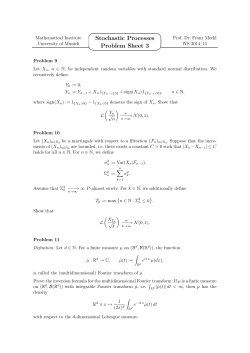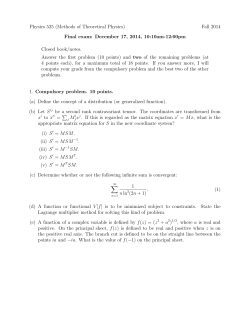
DIGITAL SIGNAL PROCESSING
DIGITAL SIGNAL PROCESSING - EHB315E (CRN:11111) Fall 2014- Course Syllabus Instructor: Assoc. Prof. Ender M. Ekşioğlu, eksioglue at itu.edu.tr, office: 2401 Lecture hours and place: Monday, 13:30-16:30, 5203 Office hours: Thursday 10:00-12:00 Teaching Assistant: Özden Bayır, bayiroz at itu.edu.tr, office: 3104 Prerequisite: An introductory course in signals and systems. Website: ninova mail list, dropbox folder Textbook: “Discrete-Time Signal Processing”, Oppenheim and Schafer, Prentice-Hall, 3rd edition, 2010. Class notes will be available in print. Some reference texts: o “Digital Signal Processing”, Schaum's Outlines, Monson H. Hayes. o “Essentials of Digital Signal Processing Using MATLAB”, Vinay K. Ingle and John G. Proakis, Adapted International Student Edition, 3rd Edition, Cengage Learning, 2012. o “Digital Signal Processing, Principles, Algorithms and Applications”, Proakis and Manolakis, Prentice-Hall. o “Digital Signal Processing : a computer-based approach”, Sanjit Mitra, Mc Graw-Hill. “Bilgisayar Uygulamalarıyla Sayısal İşaret İşleme”, A.H. Kayran ve Ender M. Ekşioğlu, Birsen Yayınevi, 2010. Course Objectives: By the end of this course, you should… o Understand the concept of sampling of continuous-time signals to produce discretetime signals and the importance and application of the Nyquist sampling theorem. o Understand discrete Fourier transforms and be able to use them to characterize discrete-time signals. o Understand z-transforms and be able to use them to characterize discrete-time signals. o Understand discrete-time systems and the concepts of linearity, causality, and stability. Know how to characterize linear time-invariant discrete-time systems in the time domain through the use of convolution (impulse response) and difference equations. Know how to characterize linear time-invariant discrete-time systems in the frequency domain through the use of discrete-time Fourier transforms (frequency response) and z-transforms (transfer functions). o Know how to represent discrete-time systems using block diagrams. Know how to determine the stability of discrete-time systems in both the time domain and frequency domain. Know techniques for implementation of discrete-time systems. o Understand the basic concepts of infinite-impulse-response digital filters, finiteimpulse-response digital filters. Know how to design finite- and infinite impulseresponse filters. Understand the concept of the fast Fourier transform. Homework: A due date will accompany each homework assignment. You will be neither excused from nor granted any extension for an assignment without prior approval from the instructor. Academic Integrity: Homework and examinations are expected to be the sole effort of the student submitting the work. Attendance: Attendance is required for at least 2/3 of the course hours, i.e. for at least 10 class sessions. Grading criteria: Percent of final grade Homework and Quizzes: 10% Exam 1: 20% Exam 2: 20% Final exam (cumulative): 50% Tentative Course Outline: Topic Tentative timetable and textbook sections Introduction. Discrete-time signals in the time domain. Week 1 (2.1, 2.2) Discrete-time systems in the time domain. Linear time-invariant systems, convolution. Week 2 (2.3, 2.4, 2.5) Frequency domain representation of discrete signals and systems. Week 3 (2.6) Discrete Time Fourier Transform (DTFT). Week 4 (2.8, 2.9) Week 5 Sampling theory. Discrete-time processing of analog signals. Week 6 (4.1, 4.2, 4.3, 4.4) (3.1, 3.2, 3.3) z-transform. Week 7, Exam 1 z-transform. Transform analysis of systems. Week 8 (3.4, 3.5, 5.1, 5.2) System function. Stability and causality. Week 9 (5.2, 5.5) Discrete Fourier Transform (DFT), circular convolution. Week 10 (8.5, 8.6, 8.7) Fast Fourier Transform (FFT). Week 11 (9.2, 9.3) Implementation of and structures for discrete systems. Week 12 (6.1, 6.3, 6.4, 6.5) Digital filters: specifications. FIR filter theory and design methods. Week 13, Exam 2 (7.1, 7.5) IIR filter theory and design methods Week 14 (7.2)
© Copyright 2025





![[ ] sin [ ] - Oregon State University](http://cdn1.abcdocz.com/store/data/000701149_1-0bf1cae8507d705aa8597319f112cba3-250x500.png)





